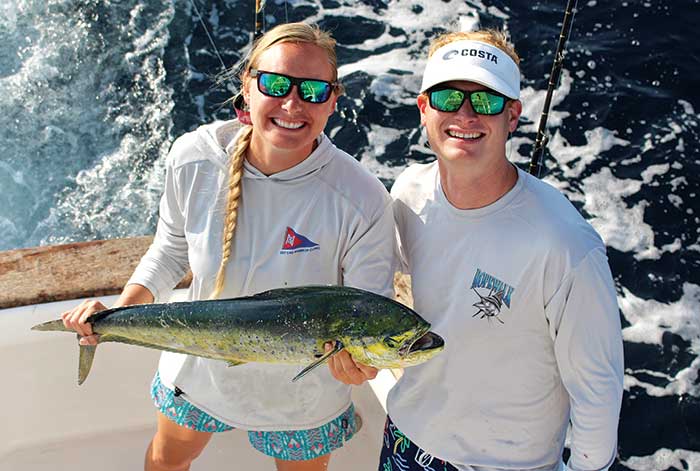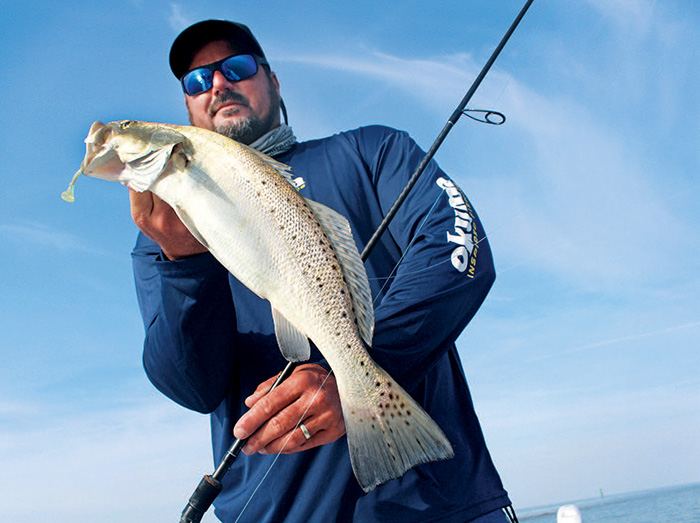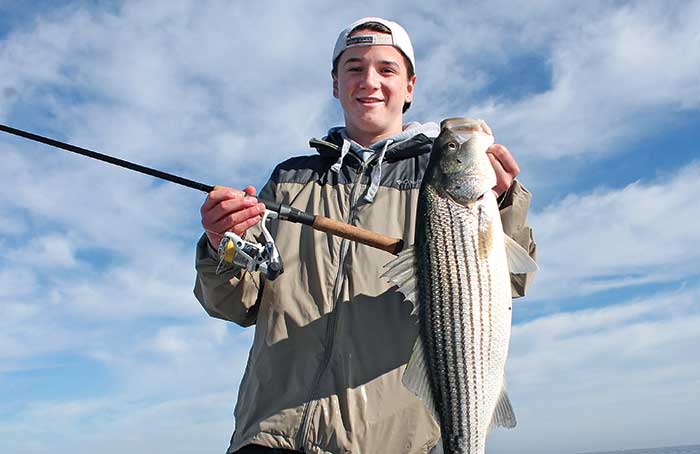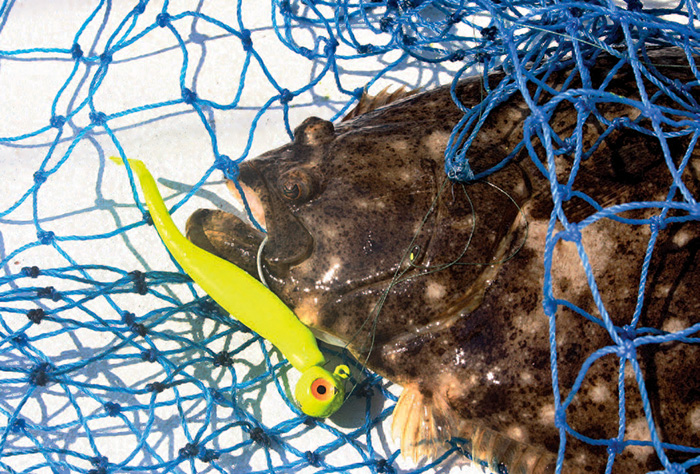Advertisement
This debate may never be settled, but we put bait up against lures in varied situations and learned quite a bit about which is "better."

Mahi-mahi love bait. Of that there is no doubt. (Photo: Lenny Rudow )
As far back as 2,000 B.C., Native Americans, ancient Egyptians, the Maori, and the Chinese had one thing in common: They'd all learned to catch fish with lures. Whether made of bone, bronze, or bird feathers, some bright fisherman realized he could fool those finned critters out of the water and onto his campfire spit with inanimate objects. And you can bet, even then, other anglers puffed out their chests and claimed that they could have caught even more fish by using bait. Eons later, in fishing forums, internet chat rooms, and sportfishing yacht saloons, the debate rages on — which is better, bait or lures?
This question runs deep through the core of our angling anatomy, so we figured we'd put the debate to a real-world test. Several anglers climbed aboard in different locations, hunting for a variety of species in hand-to-hand fishing combat between bait and lures. We admit some of the results were rather shocking. Ready to be surprised? Here's what we've learned.
Flounder In Coastal Bays
If ever there was a fish you'd think would favor bait over lures, it would be flounder. These flat fish get to give every future meal a hairy double-eyeball, as they lie on the bottom with both eyes pointing up. They should have a relatively easy time picking out visual cues. Say, for instance, when the morsel they're looking at appears to have the head of a fish but the tail of a shrimp. You'd think a detail like that might tip them off. Yet the rig that caught the most fish was a bucktail (which resembles a baitfish) tipped with a plastic GULP lure ... shaped like a shrimp. Team Bait was using the classic minnow/squid combination on "Fluke Killer" rigs, and they caught just one third as many fish.

Fish aren't the only factor to consider when matching up bait versus lures. Conditions play a role, too. (Photo: Lenny Rudow)
Of course, as is often the case when it comes to fishing, there's more to the story. Team Bait missed a number of strikes — at least a half-dozen or so — and flounder are notoriously difficult to set the hook on. This species grabs its prey in its teeth and then shakes its head to injure or kill it. When a flounder does this to a minnow on a hook, at the other end of the line, there's a rapid-fire series of vibrations, which tempt even the most patient angler to react. But if you try to set the hook at this moment, you'll usually miss the fish since it's holding only the bait, and doesn't yet have the hook in its mouth. Instead, an angler needs to wait until feeling a distinct "thump-thump-thump" that indicates the flounder has eaten its meal and is swimming away.
With jigs, on the other hand, the hook is significantly farther aft, coming out of the soft plastic a third to one-half of the way back. When a flounder grabs it, most of the time the hook is included in the deal.
Lessons Learned: Looking back at the experience, even though lures caught the most fish by far on that particular day, judging by the number of bites it's possible that a practiced flounder angler could win the fishing competition using bait. In other words, whether bait or lures is better in this particular situation depends as much on who's doing the fishing as it does on what he or she is fishing with.
Striped Bass In The Chesapeake
We stacked the deck in this competition by filling the livewell with two dozen healthy spot. In the Chesapeake, spot are known as "striper candy" because the striped bass slurp them up at every opportunity. It took two days of pre-fishing because it was early June, when spot were just beginning to trickle into the area. (Normally, a competent angler can catch two-dozen spot in a matter of minutes). We figured it was worth the effort. Then we went fishing — and that stacked deck fell right over. Team Bait didn't catch a single fish on those spot, while Team Lures racked up dozens of striped bass as well as a few bluefish by casting BKD lures.
How the heck could lures catch all those fish while the spot went untouched? At first, it was a mystery. In fact, we discussed the startling results on and off for weeks, and then we started seeing spot mentioned in all the local fishing reports as the "hot bait."
With the sudden advent of spot as the fish-catching bait of choice, our experience suddenly made sense. We had neglected to remember a basic tenant of fishing: Match the hatch. Sure, stripers love eating spot. But when few of them are around, the predators are focused on other things. They probably weren't chasing our spot simply because they weren't accustomed to seeing and eating spot at that time of year. Instead, they were much more intent on eating the already plentiful bay anchovies and silver-sides which, coincidentally, closely matched the profile of our BKD lures.

When will lures out-fish live spot for striped bass? When the spot don't match the hatch. (Photo: Lenny Rudow)
Lessons Learned: The best bait in the world is only the best when the fish want to eat it. When choosing a bait, consider seasonality and the availability of that bait in the area you'll be fishing.
Mahi-Mahi At The Canyons
Few fish are as exciting to battle as mahi-mahi — they leap clear of the water and cartwheel through the air; dazzle you with their bright green, yellow, and blue colors; and they fight with every ounce of strength in their bodies. So we were excited for a test targeting these fish. This time, bait pulled out a solid win by catching more than three times as many fish. Yet, once again, the numbers alone didn't tell the entire story.
We were catching these fish around lobster pot floats set at the edge of the Continental Shelf, where Mahi commonly congregate in large numbers. Most of the floats we visited had more than a dozen fish milling around it, and when we first pulled up to each one, every rod onboard was bent over within seconds. After a round of fish-catching, we idled back up-current and re-approached the float. On the second shot, the fish were more finicky and usually ate only the baits. On the third approach, casting lures seemed completely useless, yet the bait still caught a fish or two. As soon as those fish became the least bit wary, the lure's effectiveness clearly plummeted.

Lures won when it comes to flounder — but not necessarily for the reasons you might think. (Photo: Lenny Rudow)
Lessons Learned: When you're planning to fish lures, you may want to bring some bait along, too, just in case the fish are spooky. Because when they are, it's much easier to convince them to eat if you offer them the real thing.
That lesson comes with one disclaimer, however. The lures caught the biggest fish of the day, and in general, caught most of the larger fish we hooked into. Why would bait win so handily number-wise, yet lures take the lunkers?
The reason was obvious to us as we fished: As the cut fish chunks sunk slowly through the water, they'd get eaten by the nearest fish, regardless of size. But the fast-moving lures required a chase — and the largest, fastest Mahi around would usually win that race. So if you want to focus on catching the largest fish in the school, creating a competitive feeding frenzy with a fast-moving lure is a good tactic.
Stripers & Speckled Trout In Marshy Creeks
For this test, we put jigs up against soft crab baits in Chesapeake Bay's Tangier Sound. Lures won by a mile, and whether the fish wanted to eat bait or not, there was one overwhelming reason why: With a whipping wind and a raging current, we simply couldn't keep our baits in the spots where the fish were feeding. We'd make a cast, and within a few moments the offering was swept away. Team Lures, on the other hand, constantly casting and retrieving into the current, could place the bait in the perfect spots over and over again. There were a few other tidbits we gleaned from that experience, but hey – you can't expect me to give away every last detail.
Have we answered the question of which is better, bait or lures? Not really. Clearly there's a different answer to this question with every different fishing situation, different species, and different conditions. And clearly, this debate is sure to rage on — at least for another 2,000 years or so — among anglers everywhere.
